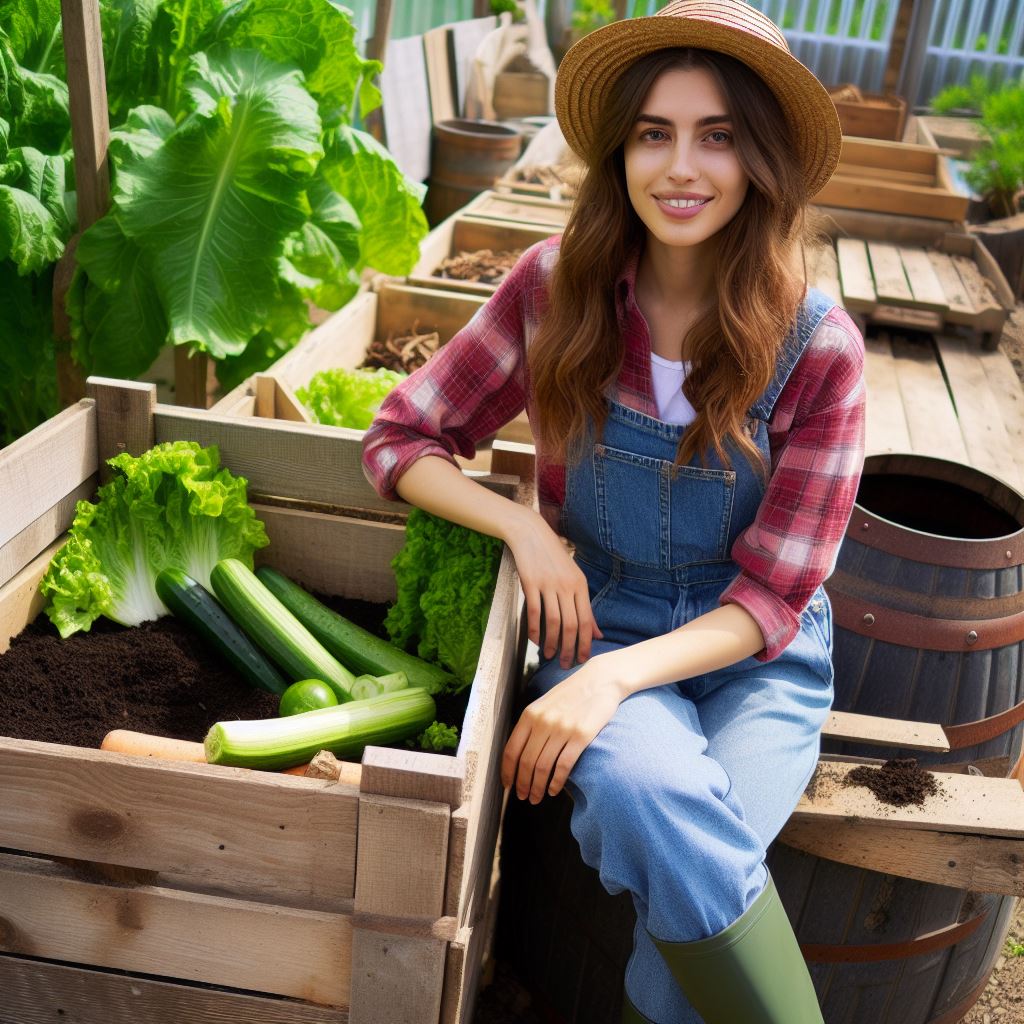Introduction
Gardening during drought is crucial as it helps maintain food supply and supports ecosystems.
Despite challenges faced by gardeners during drought, it is possible to sustain a garden.
This blog post aims to provide survival tips for gardening in drought.
During a drought, home gardening becomes vital in ensuring a steady food supply and supporting local ecosystems.
Gardeners, however, encounter various challenges in maintaining their gardens.
This post aims to address those challenges by providing effective survival tips for gardening during drought.
Gardening during drought is not only essential for personal food supply but also for sustaining local ecosystems.
Despite the challenges faced by gardeners during drought, it is possible to successfully maintain a garden through specific strategies.
This blog post aims to provide survival tips to help gardeners navigate the difficulties of gardening in drought.
In times of drought, gardening becomes even more crucial as it helps ensure a steady food source and promotes ecological balance.
However, gardeners face numerous challenges during this period.
The purpose of this blog post is to provide survival tips and strategies for gardeners to successfully navigate and sustain their gardens in drought conditions.
Home gardening during drought is of utmost importance to maintain food security and minimize environmental impact.
Yet, gardeners encounter significant challenges in this endeavor.
This blog post aims to address these challenges and provide survival tips to help gardeners cultivate and sustain their gardens during drought.
Planning for a Drought
The Significance of Planning Ahead
- In areas prone to drought, planning ahead is crucial to ensure the survival of your garden.
- Water scarcity during a drought can have a detrimental effect on traditional gardens.
- By planning ahead, you can mitigate the impact of drought on your plants and maximize water conservation.
- Planning also allows you to make informed choices about the types of plants that will thrive in dry conditions.
- It’s essential to be proactive and take necessary measures to create a resilient and water-efficient garden.
The Selection of Drought-Tolerant Plants
- One of the main aspects of planning for a drought is selecting plants that can withstand dry conditions.
- Drought-tolerant plants have evolved to survive in arid climates with minimal water requirements.
- Succulents, such as cacti and agave, are excellent choices as they store water in their leaves.
- Native plants also tend to be more drought-tolerant as they are adapted to the local environment.
- Consider planting ornamental grasses, lavender, yarrow, and sedum which are all known for their resilience.
Tips on Designing a Water-Efficient Garden
- Designing a water-efficient garden is crucial to reduce water consumption during a drought.
- Incorporate elements such as gravel paths, mulch, and rocks to retain moisture in the soil.
- Group plants with similar water needs together to avoid overwatering or underwatering.
- Install a drip irrigation system to deliver water directly to the roots of the plants, minimizing evaporation.
- Collect rainwater in barrels or tanks and use it for irrigation during the dry periods.
Additional Tips for Gardening in Drought
- Improve soil quality by adding compost or organic matter to enhance water retention.
- Apply a layer of organic mulch around plants to reduce evaporation and suppress weed growth.
- Use a layer of newspaper or cardboard under the mulch to further conserve moisture.
- Water your plants deeply and infrequently to encourage deep root growth and resilience.
- Consider using shade cloth or netting to protect sensitive plants from excessive heat and sun exposure.
- Monitor the weather and adjust your watering schedule accordingly, avoiding unnecessary water usage.
- Regularly inspect your garden for signs of drought stress, such as wilting or yellowing leaves, and take immediate action.
Planning for gardening in a drought is essential to ensure the survival and success of your garden.
By selecting drought-tolerant plants and implementing water-efficient design strategies, you can conserve water and maintain a beautiful garden even during water scarcity.
Additionally, adopting sustainable gardening practices will benefit not only your garden but also the environment as a whole.
Stay proactive, stay informed, and enjoy the rewards of a thriving and resilient garden.
Water Conservation Techniques
In the face of a drought, it is crucial to implement effective water conservation techniques in your gardening practices.
Here are some methods that can help you save water and keep your plants thriving:
Mulching
- Introduce a layer of organic mulch around your plants to retain soil moisture.
- Mulching also helps to control weed growth and regulate soil temperature.
- This technique significantly reduces water evaporation, ensuring that plants receive the necessary moisture.
- Apply a thick layer of mulch, such as wood chips, straw, or compost, around the base of your plants.
- Be careful not to pile mulch against the plant stems as it can lead to moisture-related diseases.
Drip Irrigation
- Explain the use of drip irrigation as an efficient method of watering plants.
- Drip irrigation delivers water directly to the roots, minimizing water loss due to evaporation or runoff.
- It also ensures that water is targeted only where it is needed, reducing waste.
- Install a drip irrigation system with emitters or micro-sprayers near the plants.
- You can set timers to control the duration and frequency of watering.
Collecting and Reusing Water
- Suggest collecting rainwater in barrels or containers to use for watering your garden.
- Place the barrels strategically to catch rainwater from roofs and gutters.
- This collected water is free from chlorine and other chemicals, making it ideal for plants.
- Reuse household water, such as leftover drinking water, pasta water, or water from washing dishes.
- Make sure to let the water cool to room temperature before using it on plants.
Smart Watering
- Encourage gardeners to water plants during the early morning or late afternoon to minimize evaporation.
- Watering in the evening can lead to prolonged moisture on leaves, increasing the risk of fungal diseases.
- Teach gardeners to check the moisture level of soil before watering to prevent overwatering.
- Use a moisture meter or insert a finger into the soil to determine if watering is necessary.
- Water deeply but infrequently to encourage plants to develop deep root systems and become more drought-tolerant.
Proper Plant Selection
- Advise gardeners to choose drought-tolerant plants that can withstand dry conditions.
- Native plants are often well-adapted to local climates and require less water.
- Consider grouping plants with similar water needs together to optimize irrigation.
- Avoid planting water-thirsty plants in areas where water conservation is crucial.
- Regularly monitor and adjust watering schedules based on seasonal changes and plant requirements.
By implementing these water conservation techniques, you can ensure that your garden survives and thrives even during a drought.
Conserving water not only helps your plants, but it also contributes to the overall sustainability of our environment.
Read: Urban Farming: Getting Started in Cities
Efficient Watering Practices
Efficient watering is crucial in drought.
Here’s how to water wisely and keep your garden thriving:
Importance of Proper Watering Techniques
- Prevents water waste.
- Maximizes water absorption by plants.
- Ensures healthy root development.
Guidelines on When to Water
- Water early mornings or late evenings.
- Avoid watering during peak heat hours.
- Monitor soil moisture levels regularly.
Guidelines on How to Water
- Water at the base of plants.
- Use drip irrigation or soaker hoses.
- Mulch to retain soil moisture.
Impact of Timing on Watering
- Watering during cooler periods reduces evaporation.
- Plants absorb water more effectively.
- Minimizes stress on plants.
Impact of Frequency on Watering
- Water deeply but less often.
- Encourages deep root growth.
- Helps plants withstand dry spells.
Proper watering techniques are vital for garden survival in drought conditions.
By following these guidelines, you can conserve water while ensuring your plants receive the hydration they need to thrive.
Remember, efficient watering practices not only benefit your garden but also contribute to water conservation efforts in your community.
Read: Maximize Small Spaces: Vertical Gardening

Soil Management
In times of drought, healthy soil is your garden’s lifeline. It acts as a reservoir, storing water for plants.
Adding organic matter enhances soil structure, fostering better water retention and resilience during dry spells.
Role of Healthy Soil in Drought
- Serves as a water reservoir, crucial for sustaining plant life.
- Promotes root growth, enabling plants to access stored moisture efficiently.
Importance of Organic Matter
- Enhances soil structure, reducing compaction and improving water infiltration.
- Increases soil’s capacity to hold onto moisture, crucial during drought conditions.
Tips for Soil Preparation and Maintenance
- Begin with a soil test to understand its composition and pH level.
- Incorporate compost, manure, or organic mulch to boost soil health.
- Practice minimal tillage to prevent moisture loss and soil disturbance.
- Mulch the soil surface to minimize evaporation and maintain moisture levels.
- Consider planting cover crops to protect soil and add organic matter.
- Implement drip irrigation or soaker hoses for targeted watering, minimizing wastage.
- Rotate crops to prevent depletion of nutrients and maintain soil vitality.
- Monitor soil moisture regularly and water deeply but infrequently to encourage deep root growth.
- Use shade cloth or plant taller crops to create microclimates and reduce soil moisture loss.
- Utilize rainwater harvesting techniques to collect and store water for irrigation.
By prioritizing soil management, you can create a resilient garden that thrives even in challenging conditions.
Read: Winter Prep for Your Garden & Farm
Transform Your Agribusiness
Unlock your farm's potential with expert advice tailored to your needs. Get actionable steps that drive real results.
Get StartedProtecting Plants from Heat Stress
In gardening, extreme heat can cause stress on plants, leading to various negative effects on their growth and overall health.
It is essential to take measures to protect your plants during hot weather to ensure their survival and productivity.
Effects of Heat Stress on Plants
- Wilting: Excessive heat causes plants to lose more water through transpiration, resulting in wilting.
- Stunted Growth: Heat stress inhibits photosynthesis, which reduces energy production, leading to stunted growth.
- Leaf Damage: Intense heat can scorch and burn plant leaves, eventually causing them to turn yellow or brown.
- Flower and Fruit Drop: High temperatures can cause flowers and fruits to drop prematurely, hampering yields.
- Root Damage: Heat stress can disrupt the root system, impairing the plant’s ability to absorb nutrients and water adequately.
Methods to Protect Plants during Hot Weather
To safeguard your plants from heat stress, consider implementing the following strategies:
- Provide Sufficient Water: Water your plants deeply and consistently to help them stay hydrated during hot periods. Irrigate early in the morning or late in the evening to minimize water evaporation.
- Mulch: Apply a layer of organic mulch around your plants to conserve moisture, regulate soil temperature, and suppress weed growth.
- Use Shade Cloths or Row Covers: Installing shade cloths or row covers can shield your plants from direct sunlight, reducing the intensity of heat stress.
- Create Natural Shading: Utilize existing structures like trees or tall plants to offer natural shade to smaller or more sensitive plants.
- Increase Air Circulation: Ensure proper ventilation by strategically placing fans or windbreaks to improve air movement around your plants.
- Adjust Fertilization: Avoid over-fertilizing during hot weather as it can further stress the plants. Opt for slow-release fertilizers instead.
- Time Planting: Schedule your plantings in line with the local climate to avoid exposing young plants to extreme heat.
- Pruning: Trimming excessive foliage can reduce the surface area for water loss and minimize heat stress on plants.
- Drip Irrigation: Use drip irrigation systems to deliver water directly to the plant’s roots, reducing water evaporation and minimizing heat stress.
The Benefits of Using Shade Cloths or Row Covers
Shade cloths and row covers offer several advantages when it comes to protecting plants from heat stress:
- Temperature Regulation: Shade cloths and row covers help control the microclimate around your plants, preventing temperature extremes.
- Reduced Water Loss: These covers can minimize water loss through evaporation, ensuring plants receive adequate moisture.
- Protection from Sunburn: They shield the plants from direct sunlight, reducing the risk of sunburn and leaf damage.
- Pest Exclusion: Shade cloths and row covers act as a physical barrier, preventing pests from accessing your plants.
- Improved Crop Quality: By reducing stress and maintaining consistent growing conditions, these covers contribute to better crop quality.
To sum up, heat stress can be detrimental to plants, impacting their growth, health, and productivity.
However, by implementing protective measures such as providing sufficient water, using shade cloths or row covers, and maintaining adequate air circulation, you can safeguard your plants and ensure their well-being even in extremely hot weather.
Read: Small Garden? Big Savings: Water Efficiency Tips
Gardening Techniques for Drought
Drought conditions can pose significant challenges for gardeners, but with the right techniques, it is possible to create thriving gardens even in water-scarce environments.
This section explores alternative gardening techniques that are suitable for drought conditions and discusses the concept of xeriscaping, as well as the advantages of container gardening.
Introducing Alternative Gardening Techniques
When faced with water scarcity, traditional gardening techniques may not be sufficient to maintain a healthy and vibrant garden.
However, alternative gardening techniques can help overcome these challenges and still allow for a beautiful and productive garden.
One such technique is xeriscaping.
Xeriscaping and its Benefits
Xeriscaping is a method of gardening that focuses on conserving water by using drought-tolerant plants and efficient irrigation techniques.
It is an ideal approach for gardening in drought-prone areas, as it reduces water usage while still creating visually appealing landscapes.
The benefits of xeriscaping are numerous
Firstly, it helps to significantly reduce water consumption.
By choosing plants that are adapted to dry conditions, gardeners can minimize the need for regular watering, thus conserving precious water resources.
Secondly, xeriscaping requires less maintenance.
Drought-tolerant plants are naturally resilient and can thrive with little to no irrigation.
This means less time spent on watering and more time enjoying the garden.
Furthermore, xeriscaping promotes biodiversity.
By selecting native plants that are adapted to the local climate, gardeners can attract a wide range of pollinators and beneficial insects, creating a sustainable and ecologically balanced garden.
Container Gardening and its Advantages during Drought
Another effective gardening technique during drought is container gardening.
This method involves growing plants in containers such as pots, hanging baskets, or raised beds, rather than directly in the ground.
Container gardening offers several advantages, particularly during periods of drought.
Transform Your Agribusiness Online Presence
Stand out with compelling content tailored to engage your audience and drive results. From blog posts to social media, we’ll create what your business needs to grow.
Get StartedFirstly, it allows for better control over watering.
Containers can be closely monitored, ensuring that plants receive just the right amount of water without wasting any.
This precision can be especially beneficial in conserving water during drought.
Secondly, container gardening provides flexibility.
The containers can be moved around as needed, allowing gardeners to position plants in areas with optimal sunlight and shade.
This adaptability improves plant health and productivity, even in challenging weather conditions.
Additionally, container gardening is suitable for various spaces, including balconies, patios, and rooftops.
It offers an excellent solution for urban gardeners or individuals with limited gardening space.
In short, gardening in drought conditions requires innovative approaches that conserve water and support plant health.
Xeriscaping and container gardening are two effective techniques that can help gardeners thrive even when faced with water scarcity.
By embracing these methods, gardeners can create sustainable and visually appealing gardens that withstand the challenges of drought.
So why wait? Start implementing these techniques today and enjoy a flourishing garden, even in dry times.
Harvesting and Storage
Impact of Drought on the Harvest
Drought has a significant impact on the quantity and quality of the harvest.
The lack of water affects the growth and development of plants, resulting in smaller yields and lower nutritional value.
Tips for Proper Harvesting and Storage Techniques
- Harvest your crops early in the morning or late in the evening when it is cooler.
- Use sharp and clean tools to avoid damaging the plants or introducing diseases.
- Handle the harvested produce carefully to prevent bruising or knocking off delicate parts.
- Remove any damaged or diseased parts before storing to avoid contamination.
- Store your harvested crops in a cool, dark, and dry place to prolong their freshness.
- Use appropriate containers such as mesh bags, baskets, or breathable boxes to allow air circulation.
- Avoid overcrowding the storage containers to prevent mold or rot.
- Label each container with the name and date of harvest for easy organization.
Importance of Preserving and Utilizing Harvested Produce Effectively
Preserving and utilizing your harvested produce effectively is crucial during a drought to minimize waste and ensure food security.
Here are some reasons why it is important:
- Maximizes your harvest: By preserving and utilizing your harvest effectively, you can make the most out of your hard work, even in challenging conditions.
- Reduces food waste: Proper storage and preservation techniques help minimize spoilage and prolong the shelf life of your produce, reducing the amount of wasted food.
- Ensures food security: By effectively utilizing your harvest, you can ensure a continuous supply of fresh and nutritious food, especially during periods when resources are scarce.
- Saves money: By preserving your own produce, you can save money by avoiding the need to purchase expensive store-bought alternatives.
- Promotes self-sufficiency: Preserving and utilizing your own harvest empowers you to be self-sufficient and less reliant on external food sources.
- Encourages sustainability: Utilizing your own produce promotes sustainable practices by reducing the carbon footprint associated with the transportation and packaging of store-bought food.
Overall, harvesting and storage techniques play a critical role in gardening during a drought.
By understanding the impact of drought on the harvest and implementing proper preservation methods, you can make the most of your produce and ensure food security for yourself and your family.
Discover More: Small-Scale Farming Tips for a Thriving Garden
Conclusion
Gardening in drought can be challenging, but with the right survival tips, it is possible to achieve success.
Throughout this blog section, we discussed the importance of conserving water while gardening during a drought.
We learned about techniques like using mulch, drip irrigation, and choosing drought-tolerant plants.
By implementing these survival tips, you can not only save water but also ensure the survival of your garden.
Remember to water deeply and infrequently, avoid over-fertilizing, and provide shade for your plants during the hottest hours.
Unlock Farming Insights for Growth
Make smarter farming decisions with detailed reports on market trends, weather patterns, and soil health tailored to your farm's success. Boost productivity with actionable data.
Get ReportGardening during a drought is not only beneficial for your plants but also for the environment.
By reducing water usage, you contribute to water conservation efforts and help protect our precious resources.
So, I encourage all readers to take action and start implementing these survival tips in their own gardens.
Together, we can make a difference and create beautiful, thriving gardens even in the midst of a drought.
Remember, with proper planning and care, your garden can survive and flourish, even in the most challenging drought conditions.
Happy gardening!




